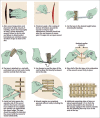Comparison of Wound Tape and Suture Wounds on Traumatic Wounds' Scar
- PMID: 29657934
- PMCID: PMC5887701
- DOI: 10.4103/abr.abr_148_16
Comparison of Wound Tape and Suture Wounds on Traumatic Wounds' Scar
Abstract
Background: Several methods have been used in wound closure for traumatic wounds, but it is not clear that which of these methods has more safety and efficacy. This study aimed to compare scar width due to standard and current treatments in wound repair by suturing and method of wound restoration using wound tape in patients with traumatic ulcers.
Materials and methods: This randomized clinical trial was done in ninety patients with wounds in the facial area. They were divided randomly into two groups of 45. The wounds in the first group were sutured, and wound tapes were used to wound closure in the second group. After 2 months, length and width of scar and results of life-size photography were recorded in a list, especially prepared for this purpose.
Results: The mean age of the patients was 22.7 ± 12.9 years with 46 males (56.1%) and 36 females (43.9%). After 2 months, scars width in suture wound group was 2.9 mm and in wound tape group was 2.5 mm, with no statistically significant difference (P = 0.07). In patients with wound length of >20 mm, scars width was similar between groups and no significant differences was noted (P = 0.27), but in patients with wound length of <20 mm, scars width in wound tape group was significantly less than suture wound group (1.7 vs. 2.5 mm, respectively, P = 0.01). Wound complications were not significantly different between the two groups.
Conclusion: Findings revealed that scar formation in wounds lower than 20 mm treated using wound tape was lower than suture, but for wounds between 20 and 50 mm were similar between wound tape and suture.
Keywords: Scar; suture; traumatic wound; wound tape.
Conflict of interest statement
There are no conflicts of interest.
Figures
Similar articles
-
Prospective study comparing wounds closed with tape with sutured wounds in colorectal surgery.Arch Surg. 2001 Jul;136(7):801-3. doi: 10.1001/archsurg.136.7.801. Arch Surg. 2001. PMID: 11448394 Clinical Trial.
-
Comparison of various methods and materials for treatment of skin laceration by a 3-dimensional measuring technique in a pig experiment.Ann Plast Surg. 2007 May;58(5):566-72. doi: 10.1097/01.sap.0000245135.58229.e7. Ann Plast Surg. 2007. PMID: 17452845
-
Use of tape for the management of hypertrophic scar development: A comprehensive review.Scars Burn Heal. 2021 Jul 12;7:20595131211029206. doi: 10.1177/20595131211029206. eCollection 2021 Jan-Dec. Scars Burn Heal. 2021. PMID: 34290886 Free PMC article. Review.
-
A randomized trial between different suture materials (polydioxanone vs. poliglecaprone 25) and different suturing techniques (running subcuticular suture alone vs. with running horizontal mattress) in prevention of hypertrophic scar development in median sternotomy wound.J Med Assoc Thai. 2014 Aug;97 Suppl 8:S88-94. J Med Assoc Thai. 2014. PMID: 25518299 Clinical Trial.
-
Use of adhesive surgical tape with the absorbable continuous subcuticular suture.ANZ J Surg. 2003 Aug;73(8):626-9. doi: 10.1046/j.1445-2197.2003.02696.x. ANZ J Surg. 2003. PMID: 12887534 Review.
Cited by
-
Tissue Adhesives: From Research to Clinical Translation.Nano Today. 2021 Feb;36:101049. doi: 10.1016/j.nantod.2020.101049. Epub 2020 Dec 20. Nano Today. 2021. PMID: 33425002 Free PMC article.
-
Time to wound closure in facial soft tissue injuries following road traffic accidents.Int Wound J. 2024 Jun;21(6):e14910. doi: 10.1111/iwj.14910. Int Wound J. 2024. PMID: 38826063 Free PMC article.
-
Suture Techniques for Traumatic Wound Closure in the Emergency Department: A Systematic Review of Cosmetic, Functional, and Infection-Related Outcomes.Cureus. 2025 Jul 12;17(7):e87772. doi: 10.7759/cureus.87772. eCollection 2025 Jul. Cureus. 2025. PMID: 40792329 Free PMC article. Review.
References
-
- Singer AJ, Thode HC, Jr, Hollander JE. National trends in ED lacerations between 1992 and 2002. Am J Emerg Med. 2006;24:183–8. - PubMed
-
- Flynn D, Knoedler MA, Hess EP, Murad MH, Erwin PJ, Montori VM, et al. Engaging patients in health care decisions in the emergency department through shared decision-making: A systematic review. Acad Emerg Med. 2012;19:959–67. - PubMed
-
- Singer AJ, Hollander JE, Valentine SM, Turque TW, McCuskey CF, Quinn JV. Prospective, randomized, controlled trial of tissue adhesive (2-octylcyanoacrylate) vs standard wound closure techniques for laceration repair. Stony Brook Octylcyanoacrylate Study Group. Acad Emerg Med. 1998;5:94–9. - PubMed
-
- Zempsky WT, Parrotti D, Grem C, Nichols J. Randomized controlled comparison of cosmetic outcomes of simple facial lacerations closed with Steri Strip Skin Closures or Dermabond tissue adhesive. Pediatr Emerg Care. 2004;20:519–24. - PubMed
LinkOut - more resources
Full Text Sources
Other Literature Sources



